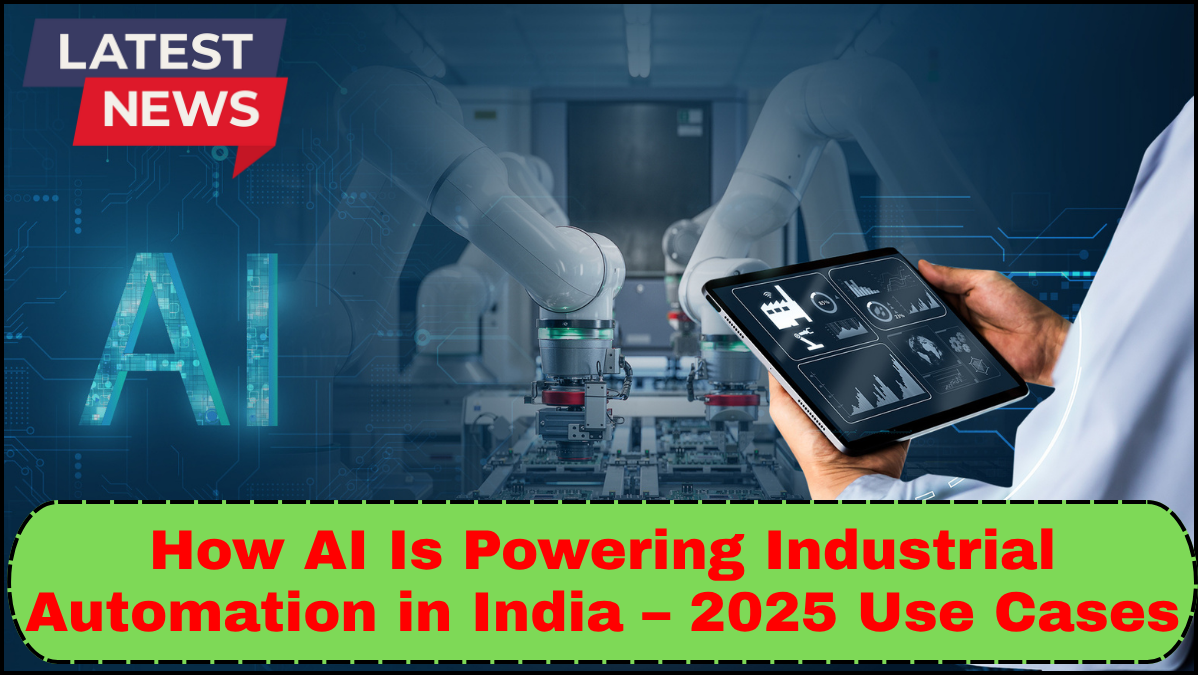Artificial Intelligence (AI) is no longer a buzzword — it’s a foundational force driving industrial automation across India. As the country accelerates its digital transformation, AI is being integrated into core manufacturing and industrial processes, delivering measurable gains in productivity, efficiency, and innovation. In 2025, the impact of AI in Industrial Automation is more visible than ever, with groundbreaking use cases shaping India’s industrial future.

Below, we explore how AI is powering this shift, highlighting top use cases and automation trends for 2025 in India’s manufacturing ecosystem.
Predictive Maintenance: Minimizing Downtime, Maximizing Output
One of the most widespread and impactful uses of AI in industrial automation is predictive maintenance. Instead of relying on scheduled checks or reactive servicing, AI systems now analyze sensor data from machinery to predict potential failures before they happen.
In India, companies like Tata Steel and Bharat Forge are already using AI to track machine vibrations, temperature fluctuations, and usage patterns. These systems not only predict equipment breakdowns but also recommend optimal maintenance windows — dramatically reducing downtime and extending machinery life.
AI-Powered Quality Control: Smarter Inspections at Scale
AI in manufacturing India is transforming how factories handle quality control. Computer vision powered by deep learning enables real-time visual inspections that far exceed human accuracy and consistency. High-resolution cameras paired with AI algorithms detect defects, misalignments, and anomalies on production lines in milliseconds.
For instance, automotive manufacturers in Chennai and Pune are deploying AI-driven inspection systems that process thousands of components daily, flagging defects with over 95% precision. This shift is slashing error rates, reducing rework costs, and enhancing product reliability.
Autonomous Material Handling: Speeding Up Logistics
Factories in India are increasingly adopting AI-guided Autonomous Mobile Robots (AMRs) and Automated Guided Vehicles (AGVs) to handle material movement. These machines, guided by AI pathfinding and real-time data from the factory floor, navigate complex layouts without human intervention.
In 2025, major logistics and manufacturing hubs — from Bengaluru to Noida — are leveraging this technology to streamline intralogistics. These smart robots are reducing manual handling errors, increasing speed, and improving worker safety in warehouse and assembly settings.
Energy Optimization: Cutting Costs with Smart Grids
With rising energy costs and environmental pressures, AI is being used to optimize energy consumption across industrial operations. AI systems analyze usage patterns, production schedules, and external factors like weather or power tariffs to fine-tune energy consumption in real time.
In Gujarat’s industrial zones, several textile and chemical plants are implementing AI-driven energy management platforms to reduce peak loads, cut emissions, and lower electricity bills — a critical edge in highly competitive markets.
AI-Driven Supply Chain Forecasting
Fluctuations in demand, raw material shortages, and global disruptions have made supply chain forecasting more complex. AI’s ability to process vast amounts of data from suppliers, markets, and logistics networks is helping Indian manufacturers gain accurate, real-time insights.
Companies like Mahindra and Reliance Industries are using AI to improve inventory planning, optimize procurement strategies, and predict market shifts — giving them a proactive advantage in both domestic and international markets.
Human-Robot Collaboration (Cobots)
Unlike traditional robots that replace human labor, collaborative robots (cobots) work alongside human workers. Equipped with AI, these machines adapt to human input and assist in tasks that require precision, consistency, or lifting heavy loads.
Cobots are especially gaining traction in India’s electronics and pharmaceutical sectors, where tasks like assembly, packaging, and handling delicate components benefit from the synergy of human intelligence and robotic consistency.
The Road Ahead: Key Automation Trends in 2025
The evolution of AI in Industrial Automation 2025 – Top Use Cases in India is tied closely to broader automation trends emerging across the country:
-
Edge AI Adoption: More factories are using AI at the edge to process data locally, ensuring faster decisions and greater data privacy.
-
No-Code AI Platforms: Empowering plant managers and engineers to build and customize AI tools without writing complex code.
-
Industrial IoT + AI Integration: Connecting machines, sensors, and AI algorithms into seamless digital ecosystems for end-to-end process visibility.
FAQs: AI in Industrial Automation India 2025
Q1: Which sectors in India are leading the adoption of AI in industrial automation?
A: Automotive, electronics, pharmaceuticals, textiles, and heavy engineering are leading sectors embracing AI-driven automation.
Q2: What are the main benefits of using AI in manufacturing India?
A: Improved efficiency, reduced downtime, enhanced product quality, optimized energy use, and better demand forecasting.
Q3: Are Indian SMEs adopting AI in their manufacturing processes?
A: Yes, with the rise of affordable cloud-based AI tools and government incentives, small and mid-sized enterprises are increasingly adopting AI technologies.
Q4: Is AI replacing human workers in Indian factories?
A: AI is augmenting human work rather than replacing it — especially through collaborative robots and decision-support systems that enhance human productivity.
click here to learn more



